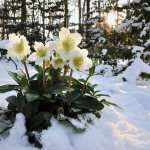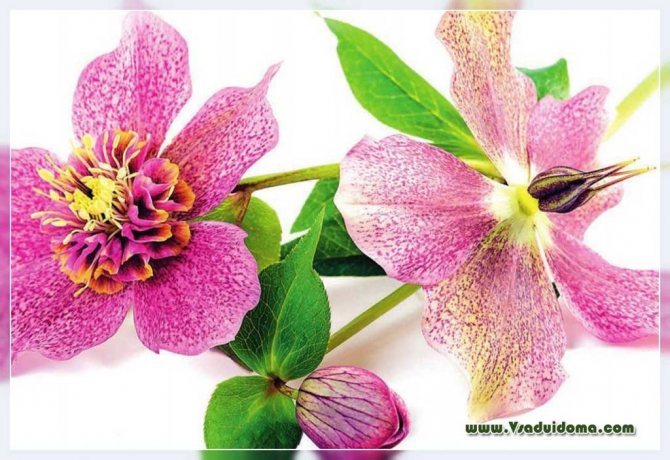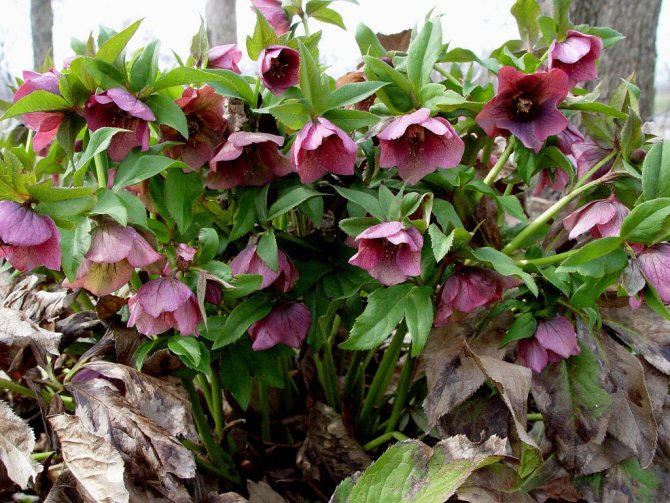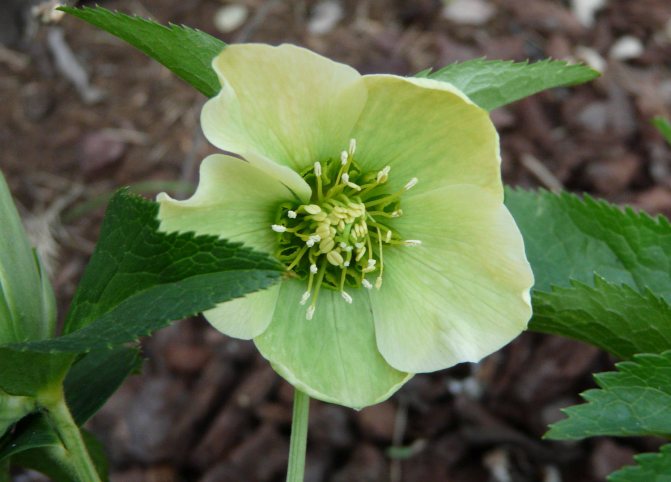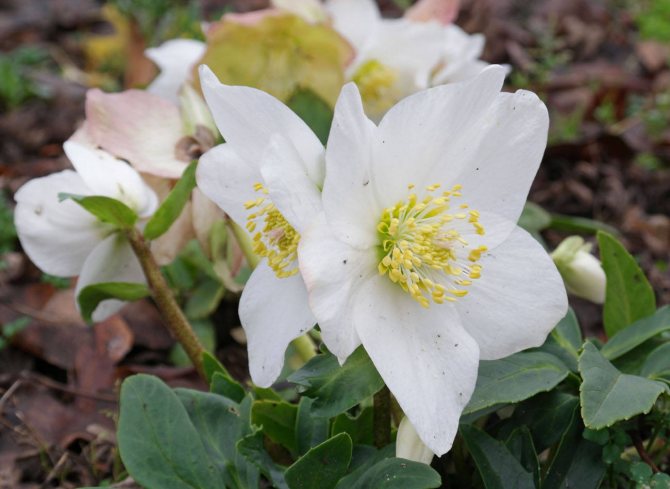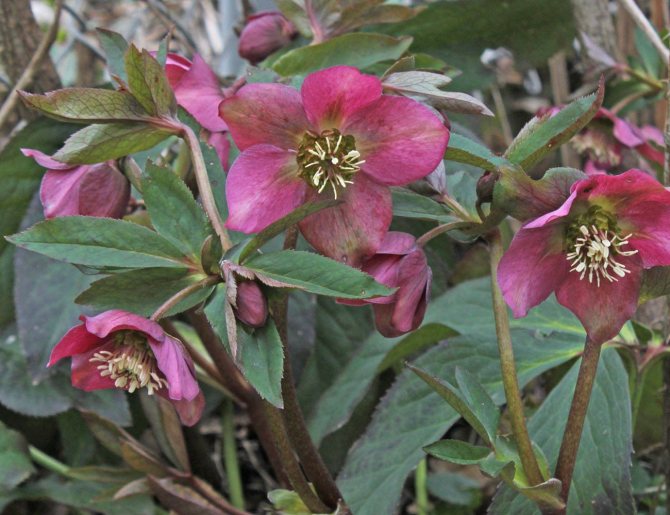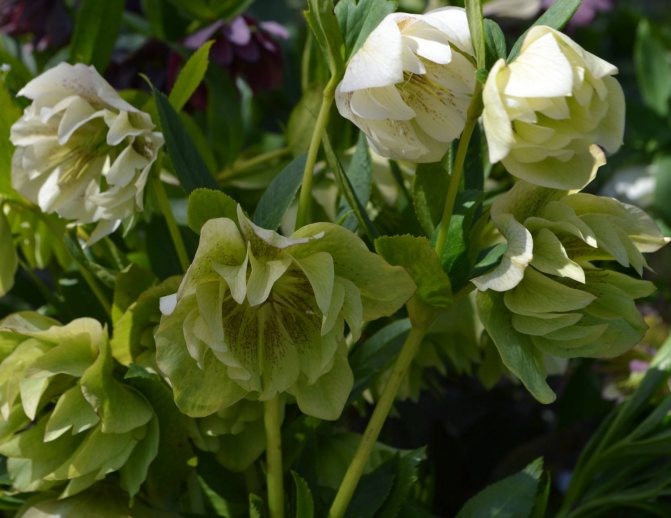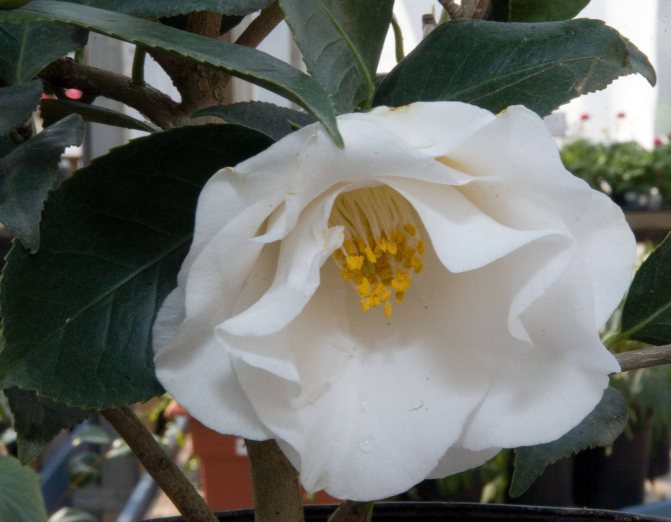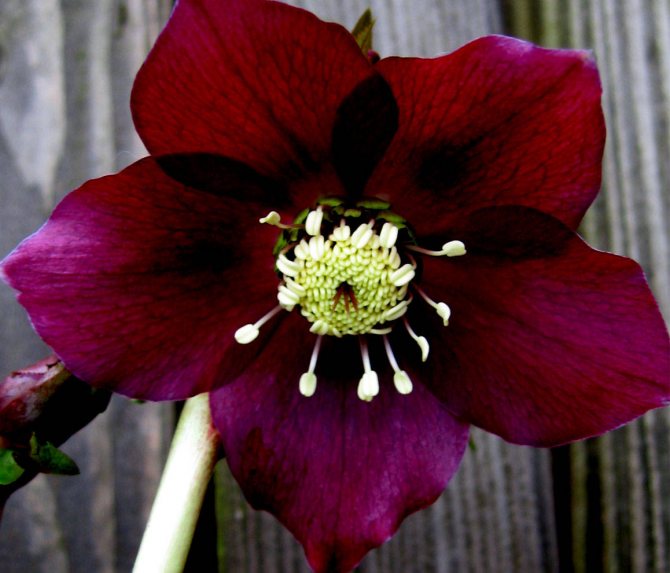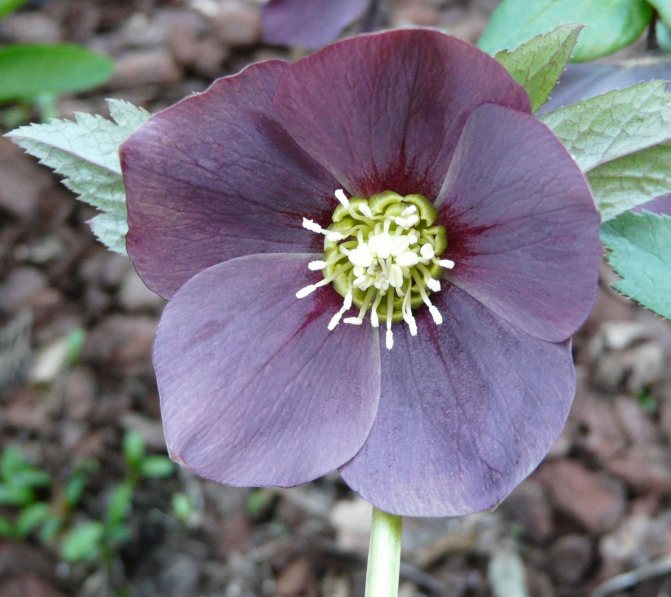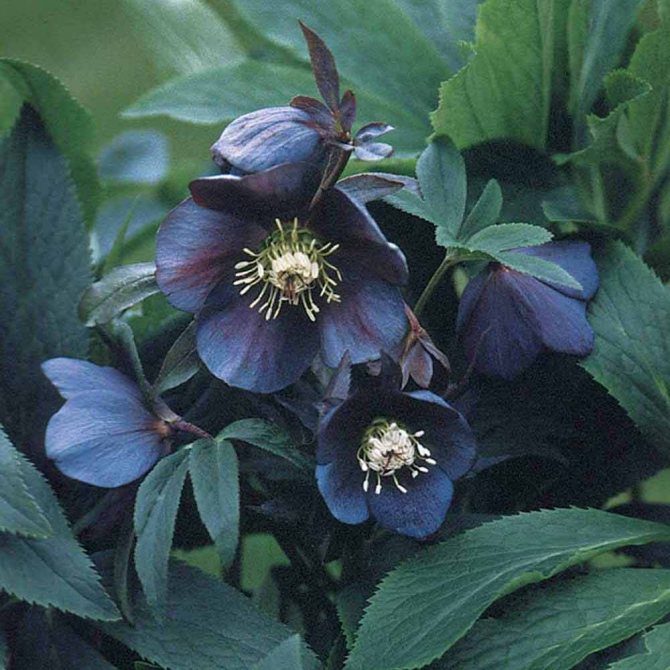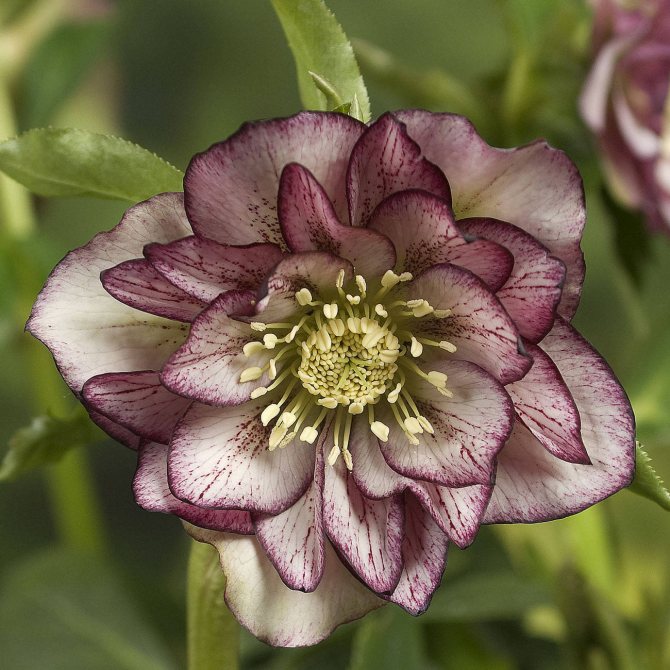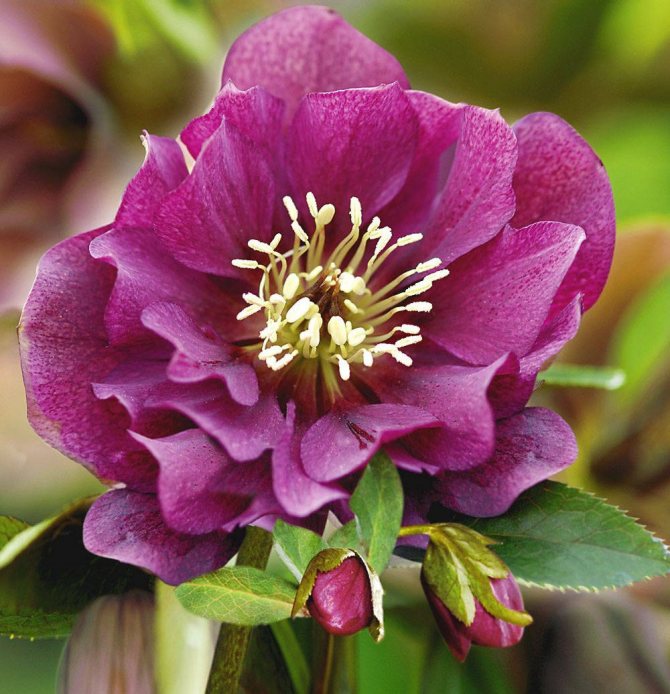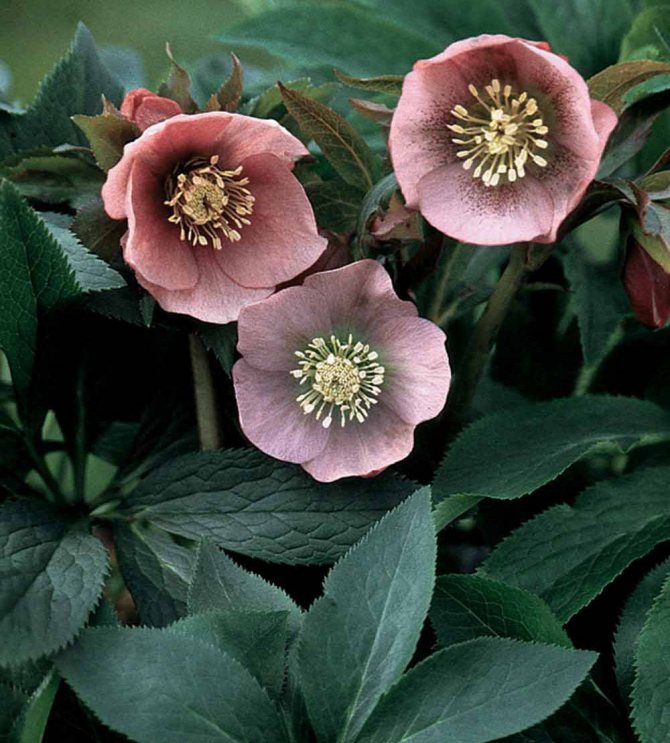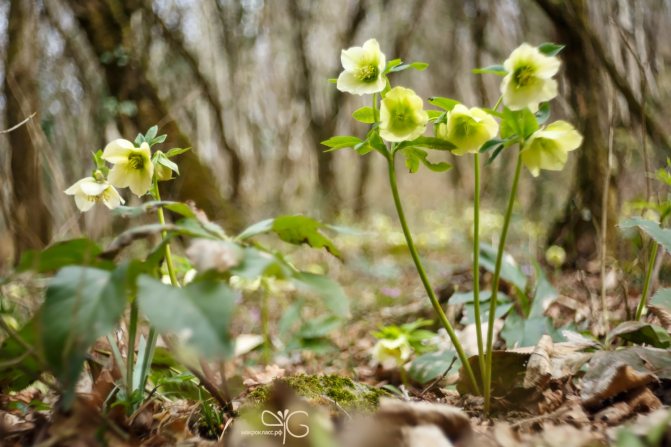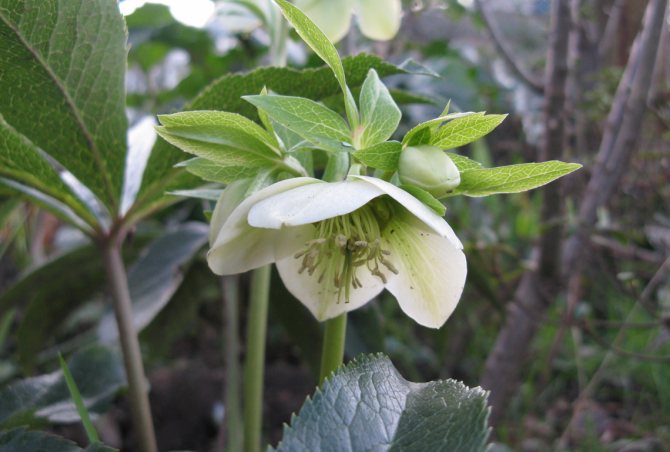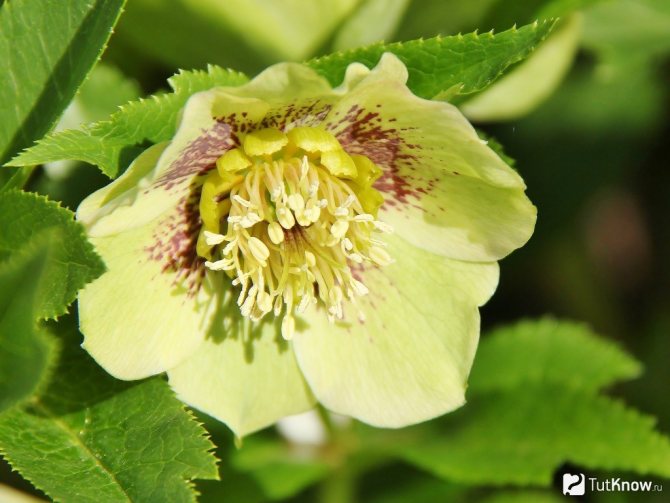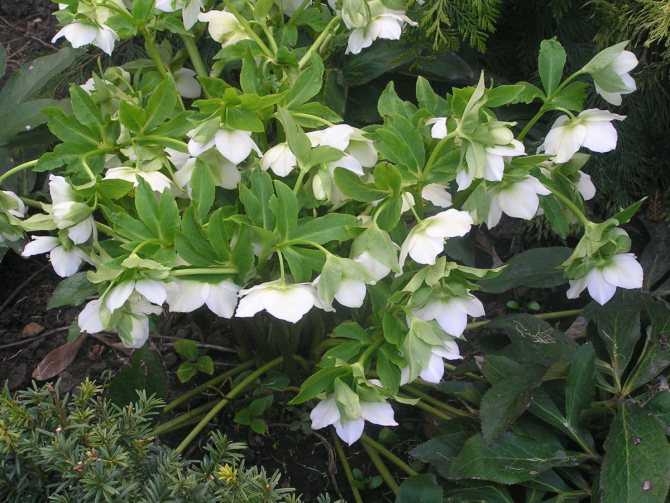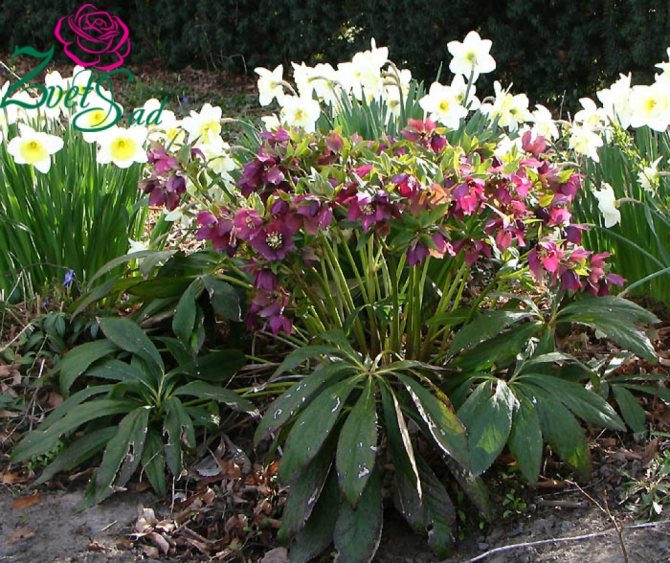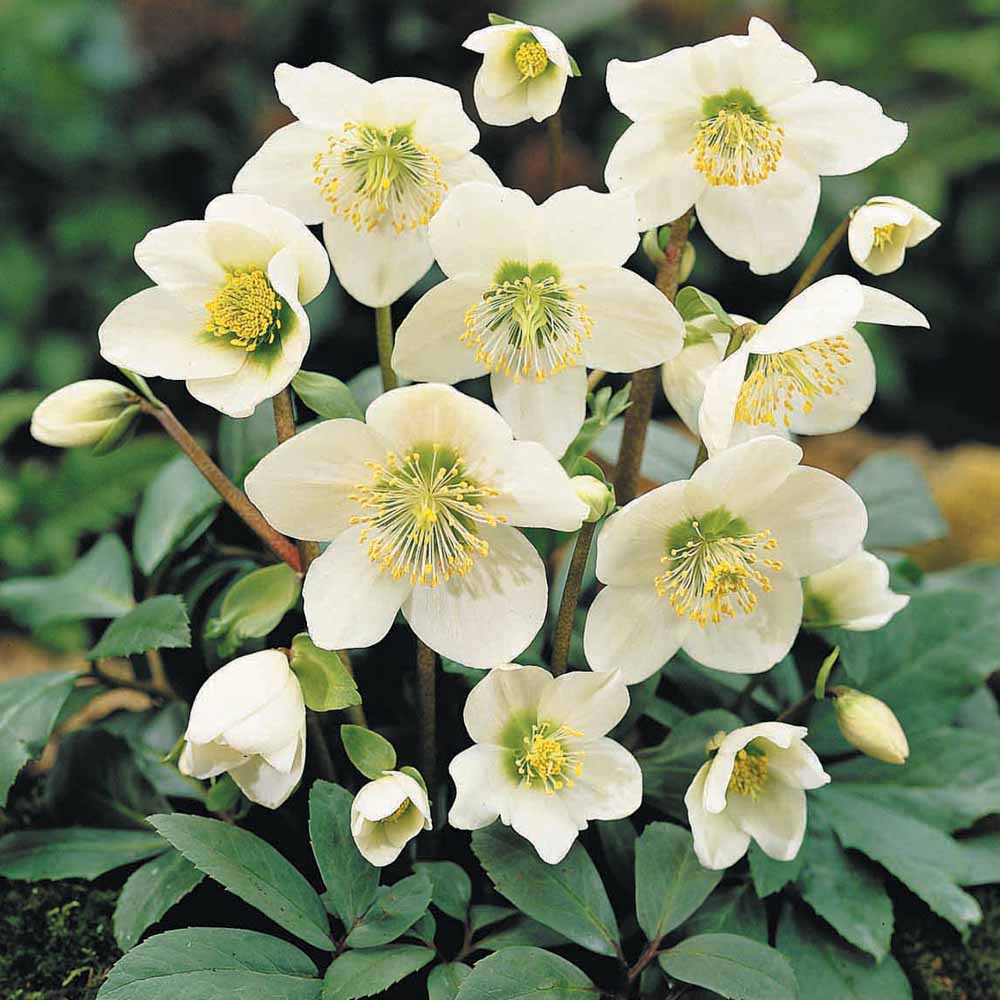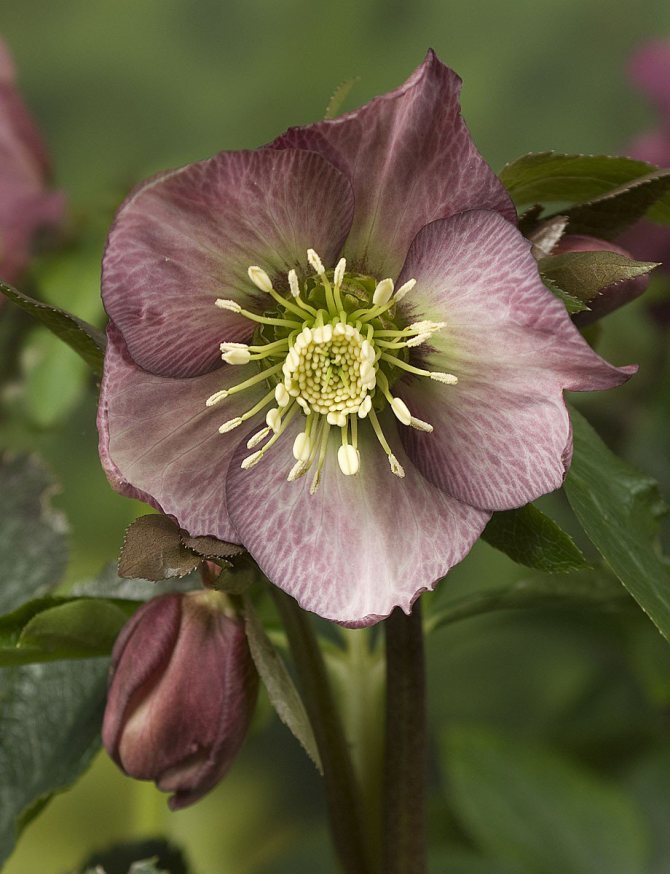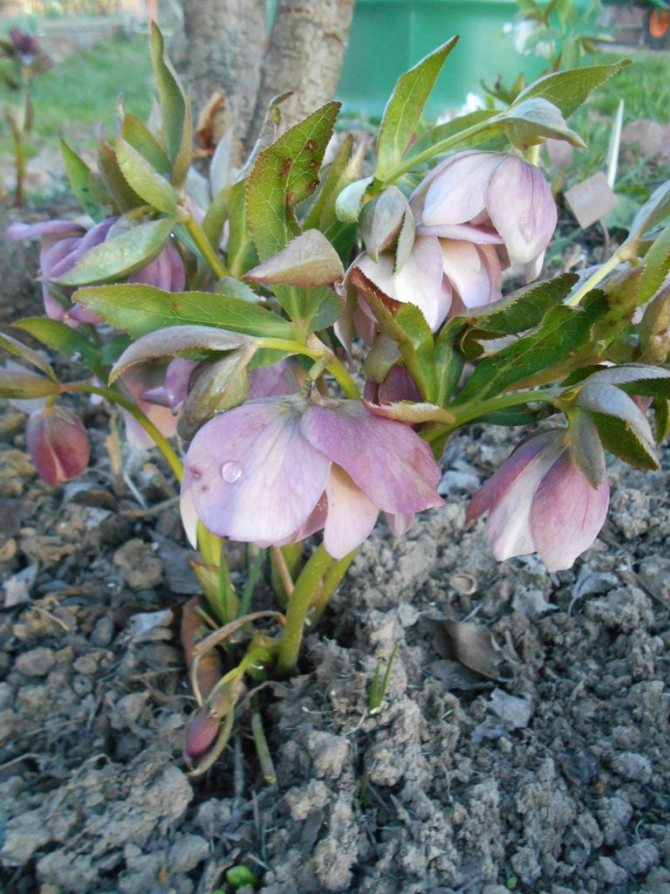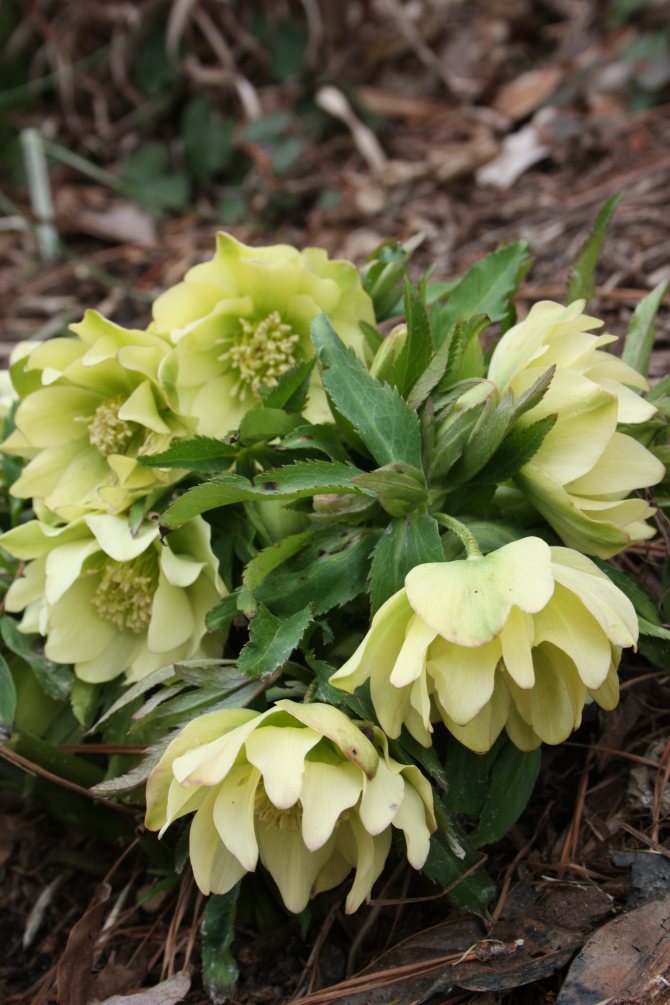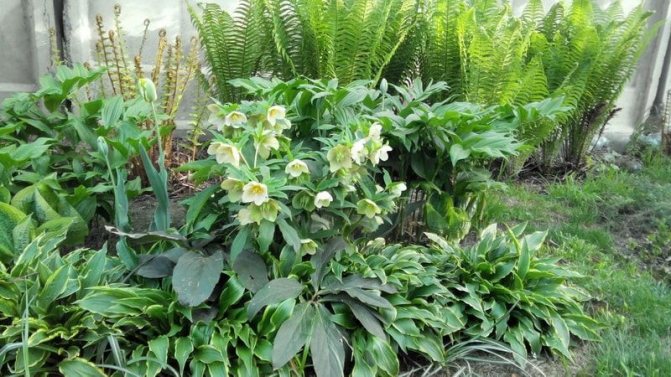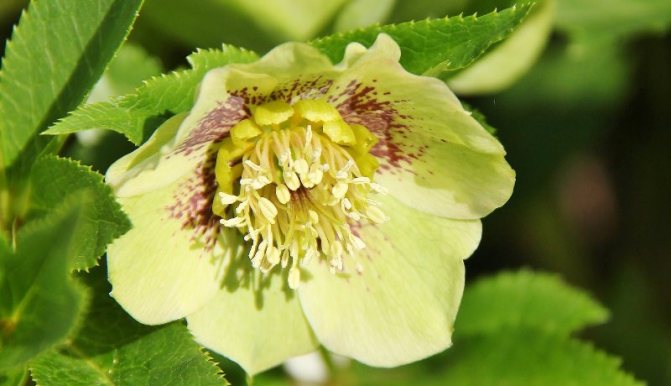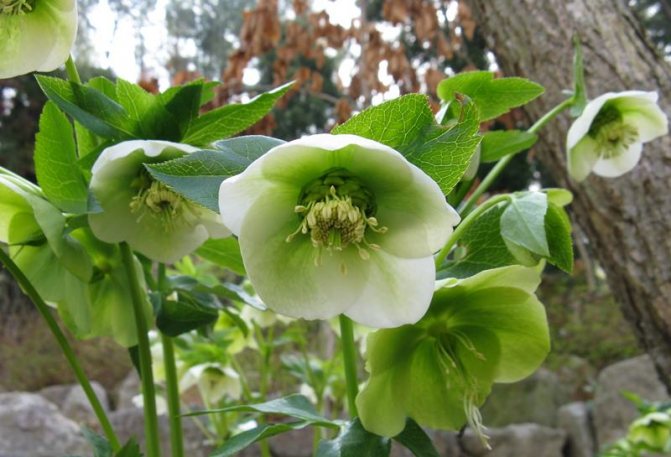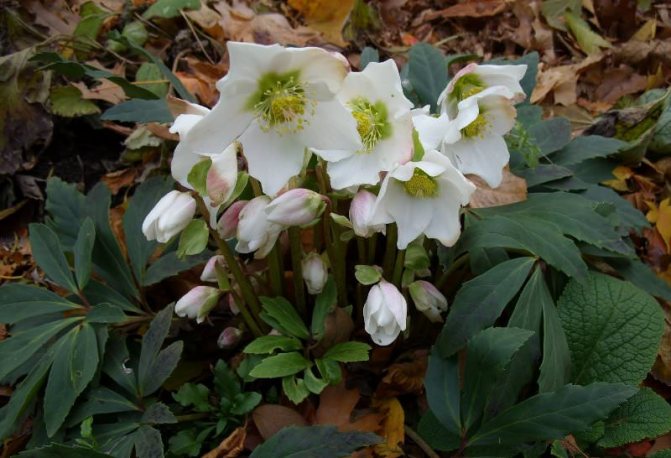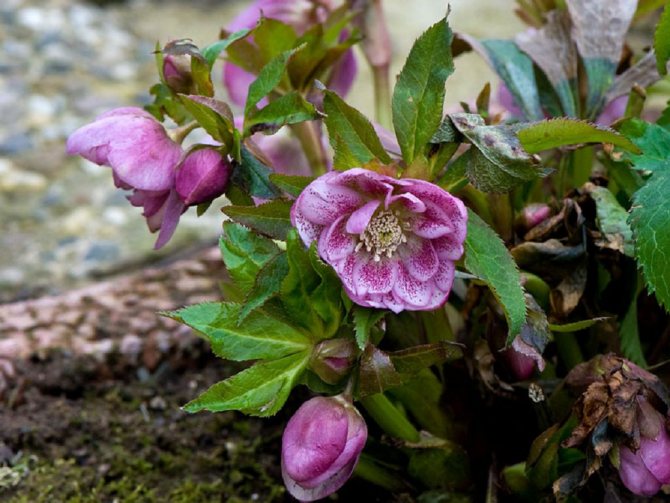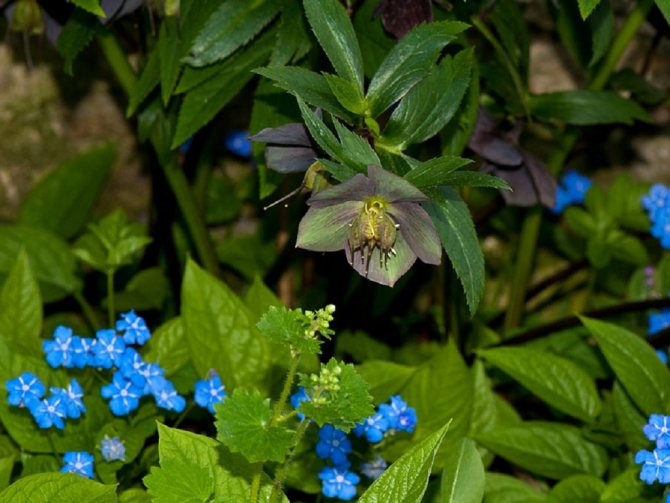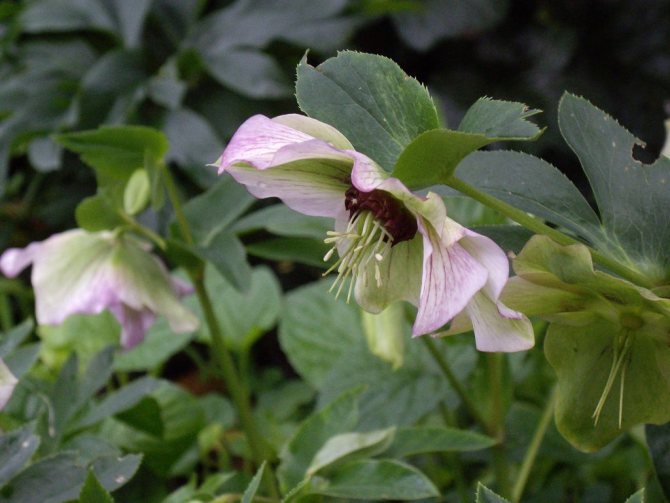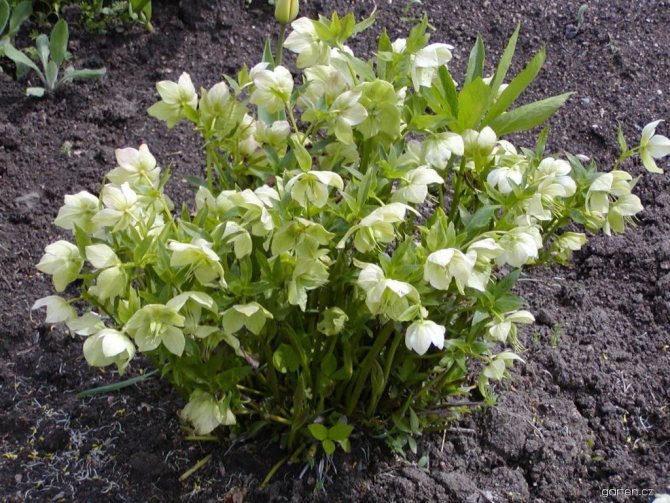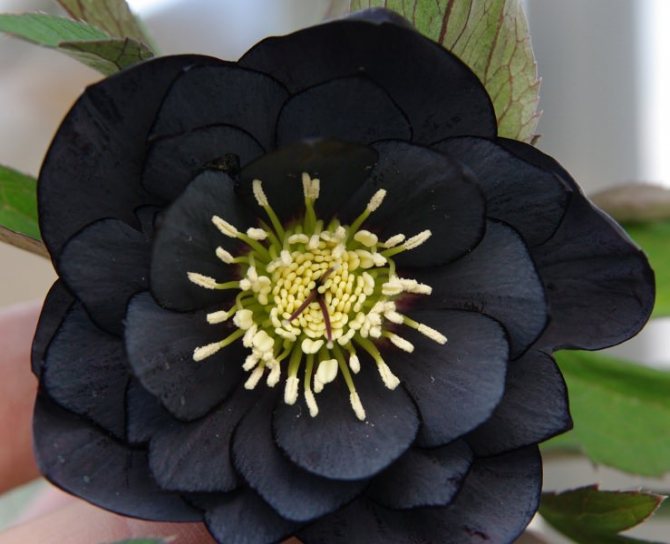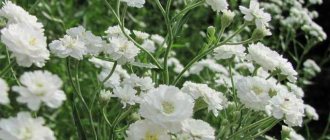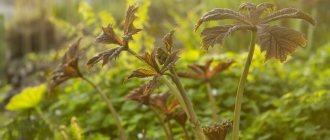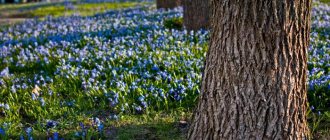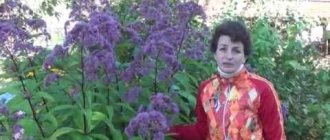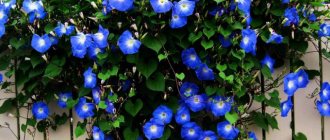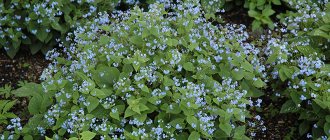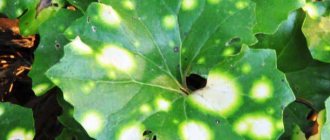The plant's incredible resistance to winter cold has gained considerable popularity among flower growers.
According to legend, the flower was born at the same time as Jesus, when the tear of a shepherd or a young girl, out of annoyance that there was nothing to give the baby, fell to the ground. Since then, the hellebore has been called the flower of Christ.
Planting and caring for an evergreen herbaceous shrub will take very little time, because it grows without requiring any special attention.
And only by showing the world wonderful flowers that unfold right from under the snow, does it surprise people with its vitality, the desire to withstand the cold and survive in such conditions where most plants die.
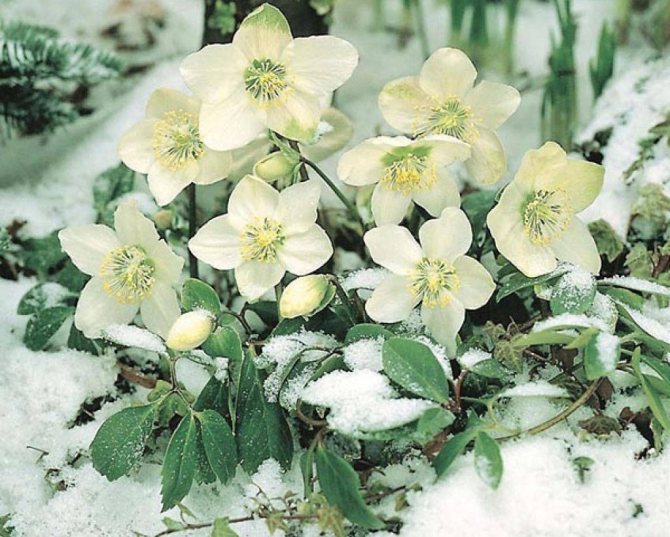
The hellebore herb has been known to people for so long that it is extremely difficult to determine its homeland. The plant is most widespread in the Balkans - there are about 10 of its species.
The range covers most of Europe, especially the Mediterranean and the mountain slopes of the Alps. In Asia, the plant is found on the border between Syria and Turkey, in Western China and the Caucasus.
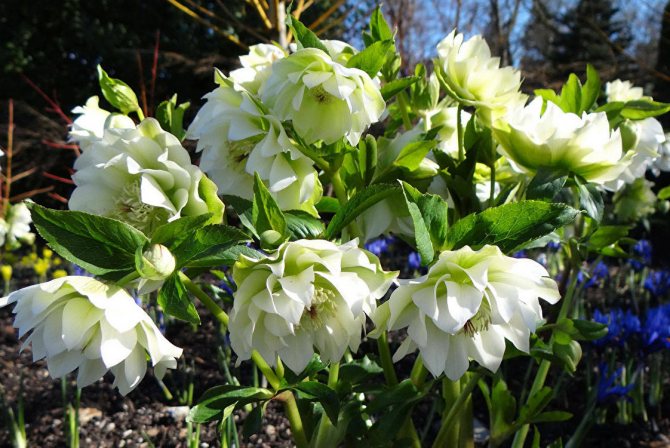

It prefers to grow in the mountains, choosing shady gorges and darkened ledges of the plateau, it develops well among the sparse growth of bushes and under the scattered veil of the crown of trees.
Hellebore features
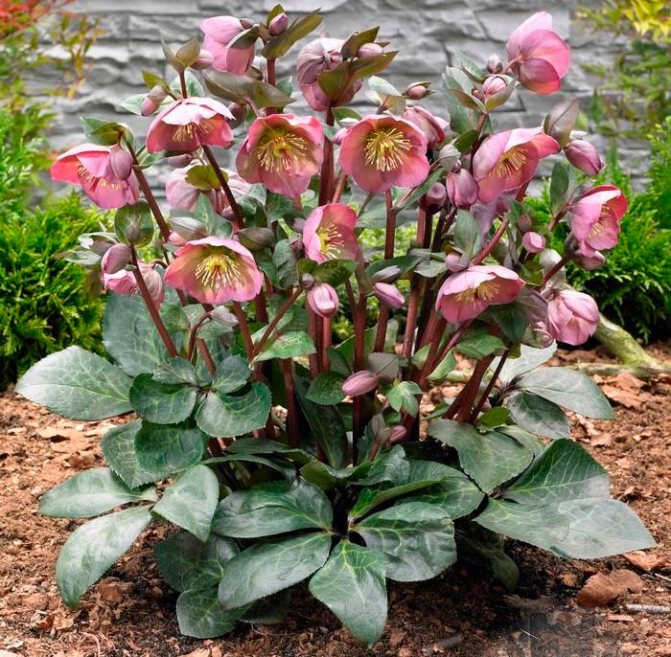

The hellebore height can vary from 0.2 to 0.5 meters. A short thick rhizome and a weakly branched simple stem. Leathery basal leaf plates have long petioles. They are stop-shaped or finger-dissected. The cupped flowers have a long stalk, they bloom at the very top of the stem. Flowering is observed from the end of the winter period to the last days of June. Sepals are often confused with flower petals. In fact, the petals were transformed into nectaries. The flowers can be colored in different shades of white, light yellow, purple, pink, violet and ink, and there are also two-tone varieties. The flowers themselves are double and simple. Many gardeners love this plant because it blooms very early, and it is so nice when beautiful flowers appear in the garden after a dull winter. But this is not its only advantage, it also has a high resistance to frost and drought. However, when planning to plant a hellebore, you must remember that it is a poisonous plant, like all other buttercups.
Photo gallery
Planting a hellebore in open ground
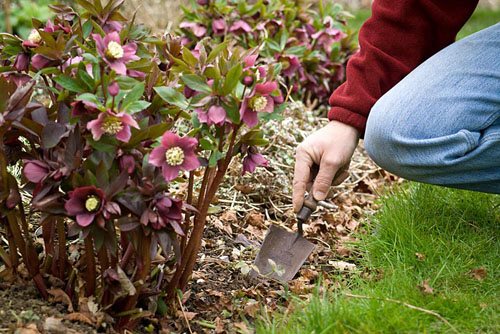

What time to plant
Without a transplant, such a flower can be grown in the same place for about 10 years. When choosing a site for planting, it should be borne in mind that the hellebore reacts extremely negatively to transplantation. In this regard, the choice of a suitable location must be taken very seriously. For growing this flower, it is best to choose a loose, moist, neutral, clayey soil that must be well drained. The site should be shaded and it is good if it will be located between shrubs and trees. To achieve maximum decorative effect from such a flower, it is recommended to plant it in small groups. The hellebore should be planted in April or September.
How to plant
The size of the planting holes should be 30x30x30 centimeters, while a distance of about 0.3 meters should be maintained between the bushes. The ½ part hole should be covered with compost.After that, the rhizome of the hellebore is placed in a hole and gradually covered with soil, which is well compacted. The planted flowers must be watered. The planted bushes need to be watered abundantly and often within 20 days from the moment of planting.
Seed propagation
Hellebore seeds do not retain their germination capacity well. Therefore, they should be used immediately after collection and not stored. Sow in nutritious, very loose soil to a depth of about one to two centimeters. The sprouts will be visible in about a month. But the hellebore will bloom only after three years.
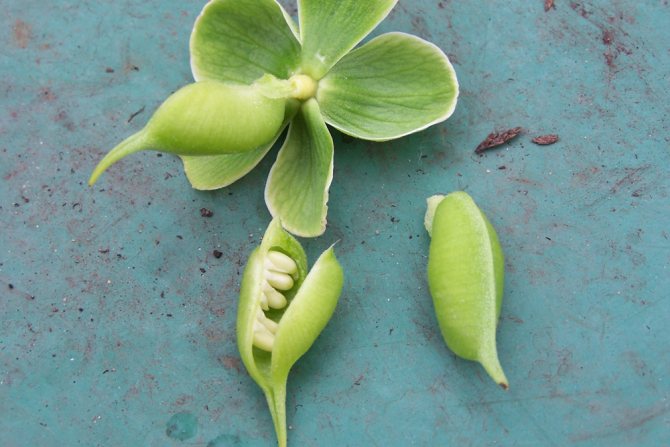

When several real leaves appear on the seedlings, they need to be cut down. An excellent place would be partial shade (for example, under a spreading tree). A hellebore can be transplanted to a permanent flower bed after two to three years. This is best done in September.
Hellebore care
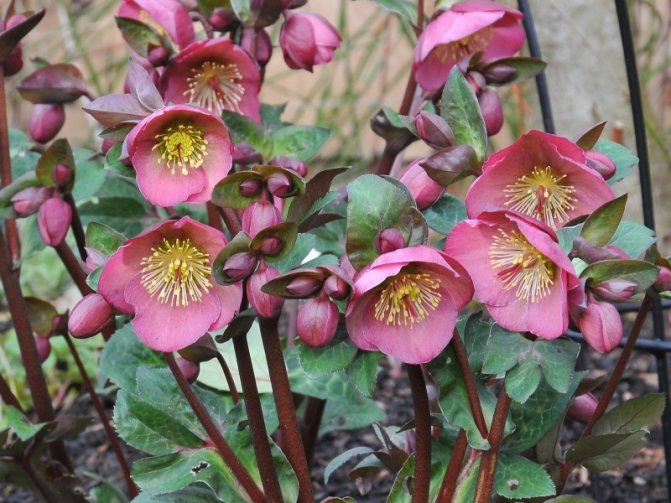

Taking care of such a flower is quite simple. Before the hellebore blooms in springtime, all old leaf plates must be cut off. This is necessary so that the plant does not become infected with fungal spot. Young leaves grow after the plant stops blooming. After the flowers wither, it will be necessary to sprinkle the soil around the plants with a layer of mulch (compost or decomposed peat). If the weather is hot, then the hellebore must be systematically watered, and weeds must be removed in a timely manner and the soil surface must be loosened. It also needs to be fed 2 times per season with mineral fertilizer and bone meal.
Hellebore propagation


Often these flowers are grown from seeds, but they can also be propagated using vegetative methods. Sowing for seedlings is carried out in the last days of June, immediately after the ripe seeds are collected. For this, humus, moist, loose soil is used, and the seeds should be buried by about one and a half centimeters. The first shoots can be seen in March next year. Grown seedlings, after the appearance of 1 or 2 pairs of leaf plates, must be dived into the flower bed (it must be located in shade). There hellebores will grow for 2 or 3 years. The transplant of mature seedlings to a permanent place can be done in September or April, while the gardener will see the first flowering only 3 years later, after the plant has fully recovered after transplantation. It should be borne in mind that the stinking hellebore multiplies well by self-seeding.
This plant is also propagated by dividing the bush. In spring, when flowering ends, those bushes that are 5 years old should be removed from the ground. The rhizome must be carefully divided into several parts, then the cuts are sprinkled with crushed coal, and then the cuttings are planted in prepared holes. In the spring, the black hellebore is propagated in this way, and for dividing the bushes of the eastern hellebore, it is recommended to prefer the autumn time.
Diseases and pests
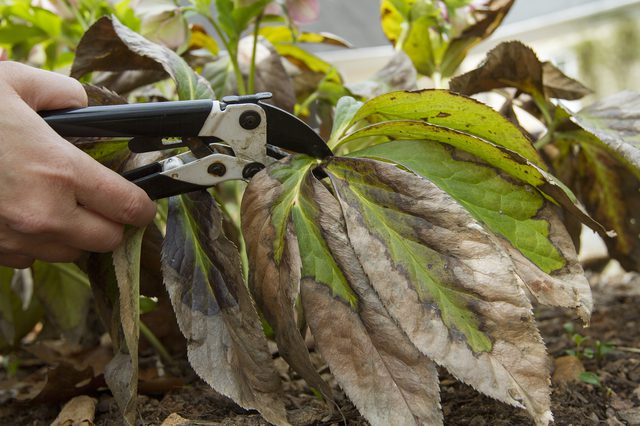

Hellebore leaves can attract gastropods such as snails and slugs, as well as mice, aphids, and also the caterpillars of the hop worm can harm it. To kill mice, bait with poison is used, which should be placed in those places where these rodents were seen. Slugs and snails are robbed from bushes by hands, and insecticides are used to kill insects, for example, you can get rid of caterpillars with Aktellik, and aphids with Biotlin or Antitlin.
The hellebore is most often affected by anthracnose, downy mildew, and ring spot. It should be remembered that aphids are a carrier of spotting, in this regard, it is necessary to take measures to combat such a pest in a timely manner. The infected parts of the bush are cut and destroyed, and then the plant and the soil around it are treated with a fungicide. If brownish-black spots with a barely visible ring pattern appear on the leaf blades, this means that the hellebore is affected by anthracnose.Infected leaves must be cut off and burned, while the bush is treated with a product that contains copper. If new leaf plates do not grow on the bush, and those that have already grown are subject to deformation, specks of a dark color appear on the front surface, and gray bloom on the seamy surface, then this means that it is affected by downy mildew. Infected parts of the plant should be cut out, while the bush and the surface of the site will need to be sprayed with copper oxychloride or Pervikur.
You should know that the hellebore is distinguished by a rather high resistance to diseases and harmful insects, and problems with it begin after violations of the rules of planting or care, for example, the plant was planted in overly acidic soil. In order to find out the acidity of the soil, you can conduct the following test, for this you need to collect 1 small spoonful of earth, pour it on the glass, which should be on the surface of a dark color, then the soil is slightly moistened with table vinegar. Then you need to evaluate the result:
- a large amount of foam indicates that the earth is alkaline;
- medium foam means the soil is neutral;
- the absence of foam indicates that the soil is acidic.
In order to fix acidic soil, it is recommended to add wood ash, fluff lime or dolomite flour to it.
Diseases
Another advantage is disease and pest resistance. Unpretentiousness, a long flowering period, frost resistance are combined in a hellebore. Planting and care, plant diseases will not give you much trouble. Diseases are not peculiar to this flower. The main thing is to look after properly, which will not take long. The hellebore can suffer from freezing temperatures. In this case, only the leaves are damaged, from which you just need to get rid of. This will not be reflected in any way on flowering or on further development. The root system will remain strong and healthy.
If spots appear on the leaves, then it is enough to spray with special preparations. Means "Oksikhom" and "Skor" help well. If the spots formed on the leaves are black, then lime must be added to the soil. Their presence indicates an excessive acidity of the soil. You also need to remember about preventive measures. It is advisable to carry out not only spraying, but also soil shedding.
If the plant begins to be affected by diseases of a non-infectious nature, then this may indicate either an increased level of soil acidity, or an excessive amount of moisture, or insufficient nutrition for the hellebore.
Hellebore after flowering
Seed collection
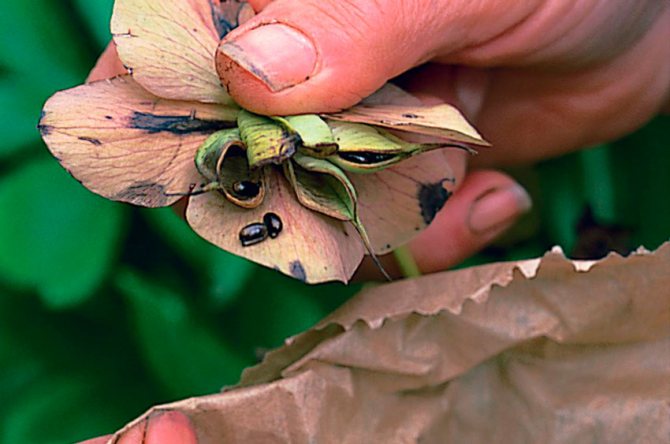

Seed ripening begins in June and can last throughout the summer. It should be borne in mind that at one point the box may suddenly burst, and the seeds will spill out onto the site. In order to prevent this, gauze bags should be put on several pieces of still unripe boxes. Then you just have to wait until the ripe seeds spill out into this bag by themselves. Then they will need to be dried by placing them in a dry, well-ventilated room. Then they are placed in a paper bag. But it is not recommended to store such seeds, as they very quickly lose their germination, in this regard, it is best to sow them immediately after collection.
Wintering
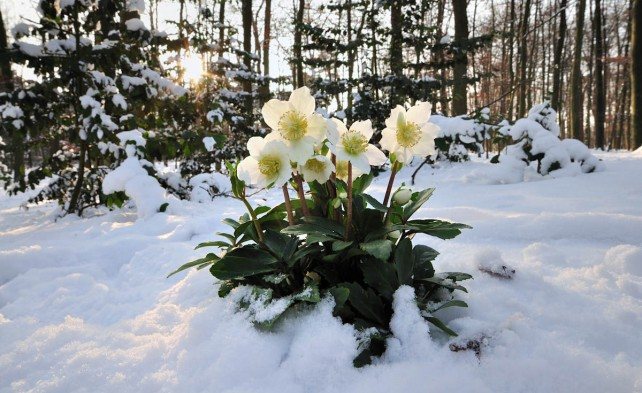

It was already mentioned above that this perennial has a very high resistance to frost. But at the same time, in a very cold, little snowy winter period, it can still freeze slightly, especially for young specimens. Therefore, for the winter, it is better to cover the hellebore with spruce branches with famously dried fallen leaves.
Medicinal properties and contraindications
Black and Caucasian hellebore is used in folk medicine. To a greater extent, they are known as a means for losing weight and normalizing metabolism. However, hellebore can be used more widely. The roots of hellebore contain a large amount of glycosides, alkaloids, saponins, coumarins, flavonoids.
If the dosage is observed, the hellebore treatment contributes to:
- lowering blood pressure and sugar levels;
- getting rid of stones and sand in the kidneys and gallbladder;
- strengthening immunity;
- prevention of oncological diseases;
- cleansing the intestines from toxins and toxins.
Weight loss occurs due to the elimination of excess fluid from the body and the normalization of metabolism.
As already mentioned, the Caucasian hellebore is especially poisonous, since it contains a large amount of active substances and has a depressing effect on the human circulatory system. Therefore, any treatment must be carried out under the strict supervision of a physician. A contraindication to taking drugs in any quantity is a tendency to allergies, childhood (up to 12 years), pregnancy and lactation. In case of an overdose, the following symptoms may appear: weakness, decreased heart rate and blood pressure, severe thirst, shortness of breath.
Types and varieties of hellebore with photos and names
There are several popular types and varieties of hellebore.
Black hellebore (Helleborus niger)
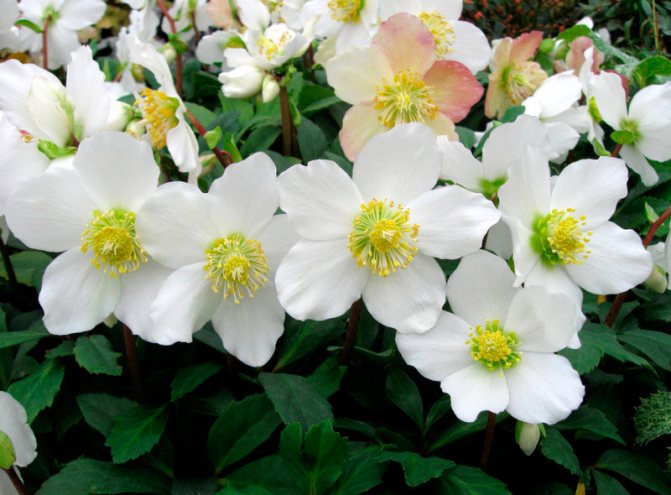

This species is one of the most beautiful and widespread. Under natural conditions, such a hellebore can be found in mountain forests from Yugoslavia to southern Germany. Such an evergreen perennial plant can reach a height of 0.3 m. The diameter of its large upward-looking flowers reaches 8 centimeters. The flowers are located on long peduncles, the height of which varies from 0.3 to 0.6 m. Inside, the flowers are snow-white, and outside are pale pink. Flowering begins in the first days of April and lasts a little less than half a month. The leaf plates of this species are hibernating, they are leathery, have a high density and a spectacular dark green color. It has a very high frost resistance (up to minus 35 degrees). In culture, this species has been since the Middle Ages. The most popular varieties are Nigristern and Nigerkors, and varieties:
- Potters Will... This variety has white flowers with the largest diameter (about 12 centimeters).
- HGC Joshua... This hellebore is the earliest, its flowering begins in November.
- Pracox... It blooms in November, the color of the flowers is light pink.
Caucasian hellebore (Helleborus caucasicus)
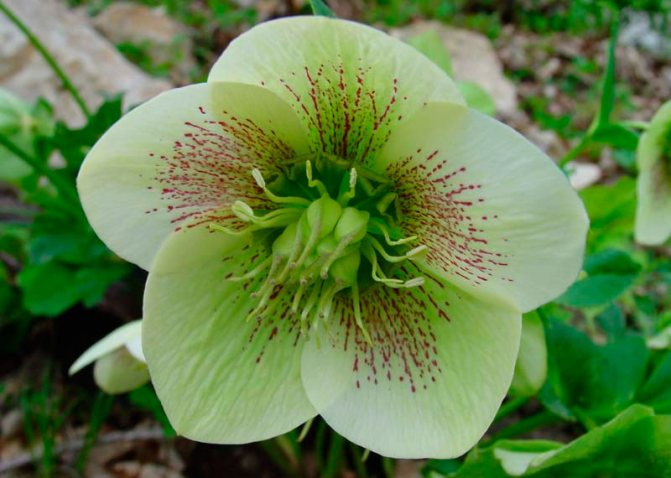

In the wild, this species can be found both throughout the Caucasus and in Turkey and Greece. Evergreen hard leathery leaf plates with long petioles can reach 15 centimeters in length, they are divided into 5-11 wide segments. The height of the peduncles can vary from 0.2 to 0.5 meters. On them there are drooping flowers, the color of which can be green-yellow with a brownish tint or white with green, and in diameter they reach 8 centimeters. Flowering begins in the last days of April and lasts 6 weeks. This species is notable for its winter hardiness, and it has been cultivated since 1853. It is considered the most poisonous of all.
Abkhaz hellebore (Helleborus abchasicus)


Bare leathery leaf plates have long petioles, their color is green-purple or dark purple. Peduncles are colored red-purple and reach a height of 0.3–0.4 meters. The diameter of the drooping dark red flowers is about 8 centimeters; sometimes you can see specks of a darker color on them. Flowering in this frost-resistant species begins in April and lasts 6 weeks. Has a variety of garden forms.
Eastern hellebore (Helleborus orientalis)
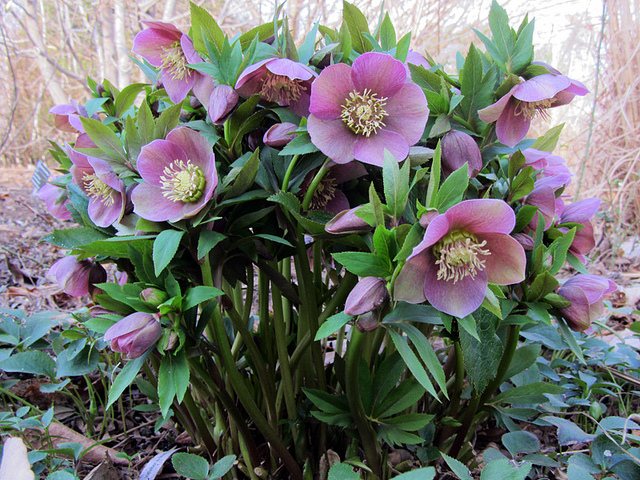

In natural conditions, it can be found in Greece, Turkey and in the Caucasus mountains. Such an evergreen perennial can reach a height of 0.3 m. The diameter of lilac flowers is 5 centimeters. Leaf plates in this species are often affected by a fungus. There are a large number of varieties, of which the following are the most popular:
- White Swan... Flowers are white.
- Rock and Roll... On the surface of the flowers of this species there are pinkish-red specks.
- Blue Anemone... The color of the flowers is pale lilac.
- Variety series Leidy Series... Erect bushes are fast-growing, flower stalks reach a height of 0.4 meters. Flowers come in 6 different colors.
Stinky hellebore (Helleborus foetidus)
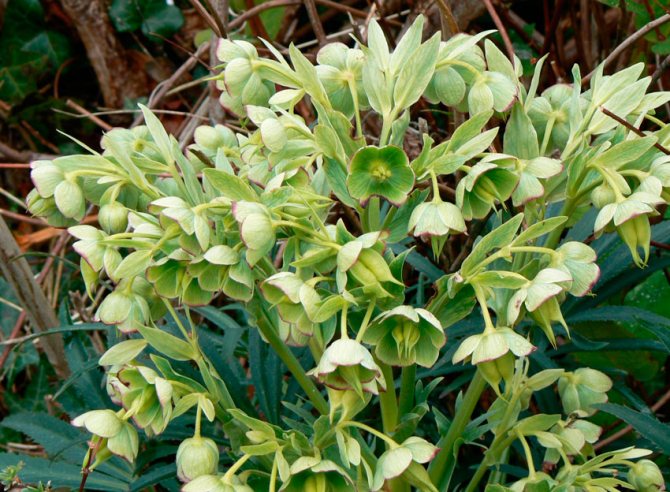

This species is native to the rocky slopes and light forests of Western Europe. Leafy shoots, by the autumn period they have a height of 0.2 to 0.3 m. The wintering leaf plates are divided into narrow dark green glossy segments. The height of the peduncles is about 0.8 meters, dense inflorescences grow on them, which include many small bell-shaped flowers that have a green color and a brownish-red edge. This species has a very high drought resistance. The most popular variety is Vester Flix: the segments of the leaves are even narrower than the main species, the branches of the inflorescences have a pale red tint.
Corsican hellebore (Helleborus argutifolius)
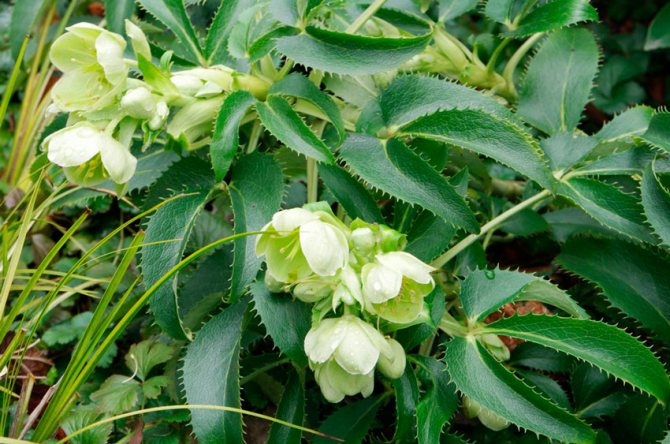

In natural conditions, it can be found on the islands of Sardinia and Corsica. Such an evergreen perennial can reach a height of about 0.75 m. There are several erect shoots that grow very quickly in width. The flowers are cupped and are green-yellow in color and are part of large, complex racemose inflorescences. Under natural conditions, such a plant begins to bloom in February, and in temperate climates around April. In mid-latitudes, shelter for the winter period is necessary for him. The most popular variety is Grunspecht: the color of the flowers is greenish-red.
Red hellebore (Helleborus purpurascens)
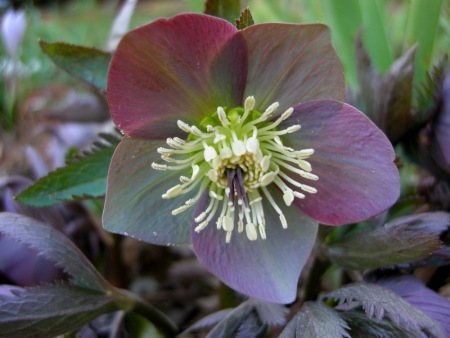

Homeland is Southeast Europe, prefers to grow on forest edges and in bushes in the territory from Romania and Hungary to the western regions of Ukraine. Large basal leaf plates have long petioles, they are finger-dissected into 5–7 parts. The front surface is bare, glossy green, and the back is glaucous. The drooping flowers are about 4 centimeters in diameter and have an unpleasant aroma. Outside, they are painted in a dusty purple-violet color, and inside - in light green, after a while they turn green. Flowering begins in April and lasts about 4 weeks. Cultivated since 1850
Hybrid hellebore (Helleborus x hybridus)
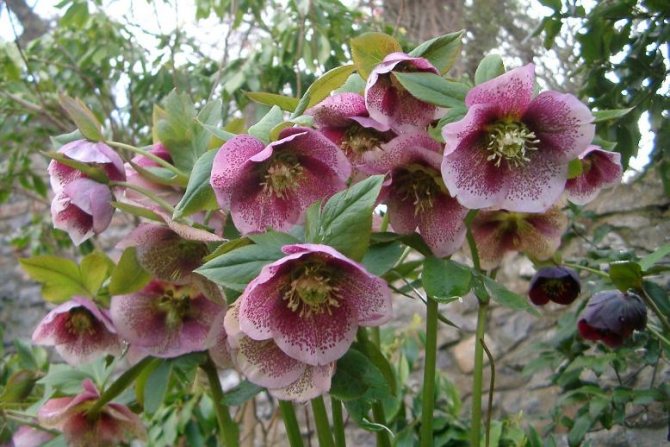

This species combines varieties of garden hybrids between different types of hellebore. Flowers can be painted in different colors and have a diameter of 5-8 centimeters. For instance:
- Violet... The central part of the white flowers is fluffy, there are also thin pink veins and a border.
- Belinda... Double white flowers with a pinkish-green glow and a border along the edge of the petals.
- Queen of the Knight... The dark purple flowers have yellow stamens.
In addition to these species, they are also cultivated such as: green, fragrant, shrub, multipart, Tibetan, Sterna, etc.
Botanical dossier
The hellebore flower is a herbaceous perennial plant with long-petiolate basal leaves, leathery and finger-dissected in species wintering with a non-dying aerial part and more delicate with a fine texture in deciduous bushes.
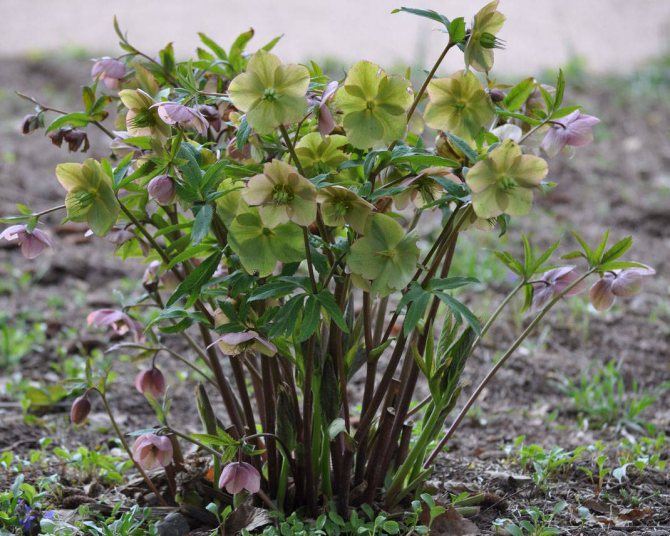

The rhizome is thick and branched with numerous black lateral roots.
Large hellebore flowers appear in early spring, often bloom when the snow has not melted yet, but snowdrops are not ahead.
In some species, they are carried by a flowering stem that develops in the spring of the current season, in others, flowers are formed from a bud at the top of a wintering leafy stem, which dies off after flowering.
The flowers are large, light green, snow-white or purple, over 10 cm in circumference.
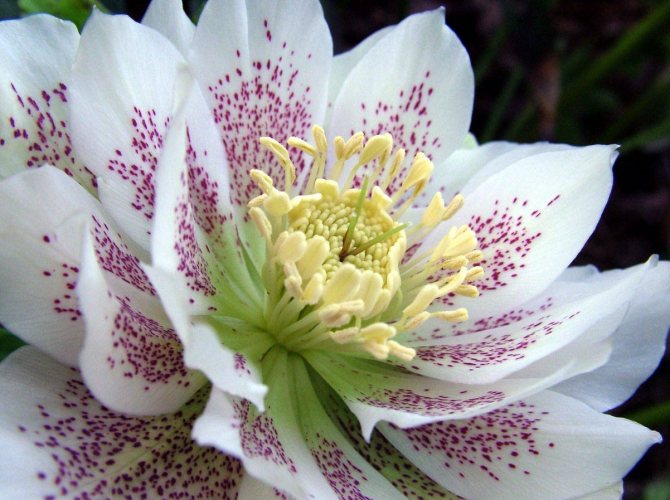

They have five sepals, many of them mistaken for petals that have not fallen for several months, but the latter have been reborn into funnel-shaped tubular small nectaries.
The fruits are multileaf with rounded black seeds.
The poisonous properties of hellebore have been known since antiquity. Many legends and historical facts indicate the use of the plant not only for medicinal, but also for poisoning purposes.
According to Greek mythology, the priest Melampus used the hellebore to heal the daughters of the king of Argos from bouts of madness.
And the inhabitants of the besieged city of Kirra were forced by the enemies to surrender by poisoning the aqueduct with the help of a plant.
And in the death of Alexander the Great, some historians blame the hellebore or the white hellebore, with which the commander poisoned himself as a result of an overdose while treating an unknown disease, possibly malaria or some other.
Origin
Having once looked at the hellebore, a photo of which will decorate any room, it is difficult to refrain from delight. A mysterious atmosphere instantly fills the space next to the flower. It was not for nothing that the inhabitants of the Middle Ages attributed to him a magical ability to protect against evil demons, they grew a flower next to their home.
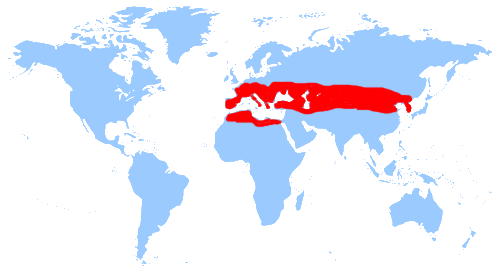

The homeland of hellebore
Numerous myths and legends are passed down from generation to generation. In the wild, natural hellebore thickets can be found along the forest edges of Asia, Europe, and the Mediterranean.
A bit of history
This flower has a very long and rich history. According to popular beliefs, it is customary to call it the rose of Christ. The plant got this name because of a long tradition that it supposedly grew next to the stable in which Jesus was born.
The next name of this plant is Gelleborus, that is, translated from Latin "killing food". Since ancient times, healers have not abandoned their attempts to make a potion for all diseases based on the healing power of this flower. But, if you believe the legends, then Alexander the Great died precisely after using the potion from the hellebore, with which they tried to cure his fever. This plant should be used with great care as a medicine, because it is very poisonous.
Gardeners reviews
IgorM
Freezers don't like the open sun. Very well sown if they have collected their seeds - germination rate is almost 100%
Murzilka
The hellebores are sown themselves, while blooming only in the third - fourth year. And when dividing the bush in the summer, it blooms in the spring.
Description of the plant
The hellebore flower is very poisonous, and therefore in official medicine it is used only as a medicinal, external remedy. The plant is very decorative, and breeders have bred about a dozen species and hybrids of the flower. These flowers are frost-hardy and very unpretentious, which is highly appreciated by flower growers.
This evergreen plant can decorate any corner of the garden. The flower is very decorative - large hard leaves grow on long petioles. The plant has no stems. The flowers are large enough, and reach a diameter of 15 cm. Flowers appear directly in the snow, as soon as the peduncle can overcome the layer of ice. The color of the flowers of this plant can be very diverse - from pure white to all shades of red.
Refers to poisonous crops
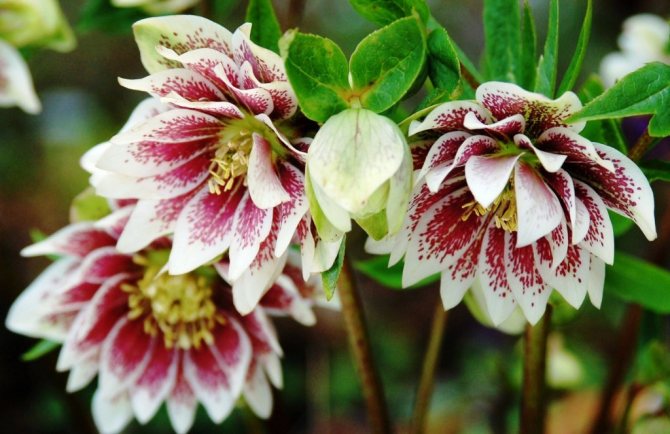

The flowers of the Hellebore can be either single-level or double. Photo:
- Natural habitats... Helleborus (Helleborus) - better known as the hellebore, in some areas called Christ's rose, Christmas rose or Winter. It grows in the Caucasus, throughout Europe, Turkey and Asia Minor. Artificially cultivated all over the world.
- Varietal affiliation... Heleborus is a member of the buttercup family. At the moment, 22 species are known. All such plants have leathery dissected leaves with varying numbers of segments. Perennial lives for about 10 years.
- Bloom... The plant can bloom either from March to June or from November to January. Depending on the variety, the duration of flowering is from 2 weeks to one and a half months. The height of the peduncle is 20 - 60 cm, the diameter of the opened bud is 4 - 12 cm, the tinting is various, there are mixed options.
- Features of the... Wintering plant belongs to poisonous crops, dangerous glycosides are present in the juice, along with this, it is considered a medicinal plant, in folk medicine, preparations for weight loss are prepared from it.

